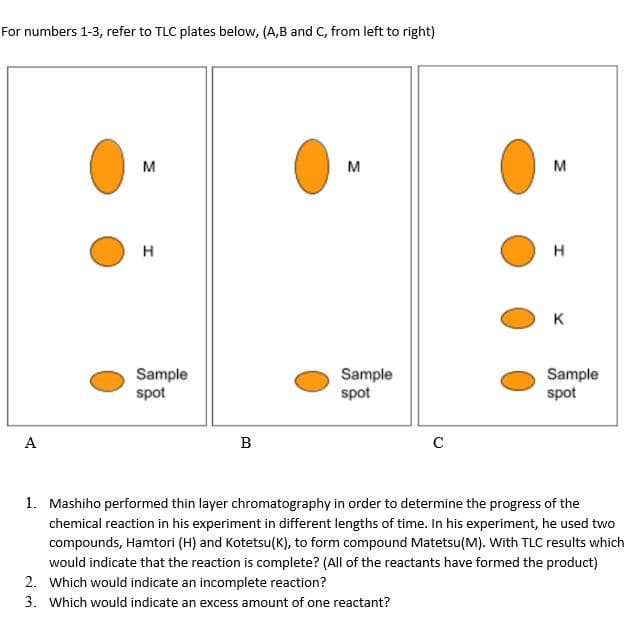For numbers 1-3, refer to TLC plates below, (A,B and C, from left to right) M M M H H K Sample Sample spot Sample spot spot A B с 1. Mashiho performed thin layer chromatography in order to determine the progress of the chemical reaction in his experiment in different lengths of time. In his experiment, he used two compounds, Hamtori (H) and Kotetsu(K), to form compound Matetsu(M). With TLC results whic would indicate that the reaction is complete? (All of the reactants have formed the product) 2. Which would indicate an incomplete reaction? 3. Which would indicate an excess amount of one reactant?
For numbers 1-3, refer to TLC plates below, (A,B and C, from left to right) M M M H H K Sample Sample spot Sample spot spot A B с 1. Mashiho performed thin layer chromatography in order to determine the progress of the chemical reaction in his experiment in different lengths of time. In his experiment, he used two compounds, Hamtori (H) and Kotetsu(K), to form compound Matetsu(M). With TLC results whic would indicate that the reaction is complete? (All of the reactants have formed the product) 2. Which would indicate an incomplete reaction? 3. Which would indicate an excess amount of one reactant?
Chemistry
10th Edition
ISBN:9781305957404
Author:Steven S. Zumdahl, Susan A. Zumdahl, Donald J. DeCoste
Publisher:Steven S. Zumdahl, Susan A. Zumdahl, Donald J. DeCoste
Chapter1: Chemical Foundations
Section: Chapter Questions
Problem 1RQ: Define and explain the differences between the following terms. a. law and theory b. theory and...
Related questions
Question
Answer the following questions.

Transcribed Image Text:For numbers 1-3, refer to TLC plates below, (A,B and C, from left to right)
M
M
M
H
H
K
Sample
Sample
spot
Sample
spot
spot
A
B
с
1. Mashiho performed thin layer chromatography in order to determine the progress of the
chemical reaction in his experiment in different lengths of time. In his experiment, he used two
compounds, Hamtori (H) and Kotetsu(K), to form compound Matetsu(M). With TLC results which
would indicate that the reaction is complete? (All of the reactants have formed the product)
2. Which would indicate an incomplete reaction?
3. Which would indicate an excess amount of one reactant?
Expert Solution
This question has been solved!
Explore an expertly crafted, step-by-step solution for a thorough understanding of key concepts.
This is a popular solution!
Trending now
This is a popular solution!
Step by step
Solved in 2 steps

Knowledge Booster
Learn more about
Need a deep-dive on the concept behind this application? Look no further. Learn more about this topic, chemistry and related others by exploring similar questions and additional content below.Recommended textbooks for you

Chemistry
Chemistry
ISBN:
9781305957404
Author:
Steven S. Zumdahl, Susan A. Zumdahl, Donald J. DeCoste
Publisher:
Cengage Learning

Chemistry
Chemistry
ISBN:
9781259911156
Author:
Raymond Chang Dr., Jason Overby Professor
Publisher:
McGraw-Hill Education

Principles of Instrumental Analysis
Chemistry
ISBN:
9781305577213
Author:
Douglas A. Skoog, F. James Holler, Stanley R. Crouch
Publisher:
Cengage Learning

Chemistry
Chemistry
ISBN:
9781305957404
Author:
Steven S. Zumdahl, Susan A. Zumdahl, Donald J. DeCoste
Publisher:
Cengage Learning

Chemistry
Chemistry
ISBN:
9781259911156
Author:
Raymond Chang Dr., Jason Overby Professor
Publisher:
McGraw-Hill Education

Principles of Instrumental Analysis
Chemistry
ISBN:
9781305577213
Author:
Douglas A. Skoog, F. James Holler, Stanley R. Crouch
Publisher:
Cengage Learning

Organic Chemistry
Chemistry
ISBN:
9780078021558
Author:
Janice Gorzynski Smith Dr.
Publisher:
McGraw-Hill Education

Chemistry: Principles and Reactions
Chemistry
ISBN:
9781305079373
Author:
William L. Masterton, Cecile N. Hurley
Publisher:
Cengage Learning

Elementary Principles of Chemical Processes, Bind…
Chemistry
ISBN:
9781118431221
Author:
Richard M. Felder, Ronald W. Rousseau, Lisa G. Bullard
Publisher:
WILEY